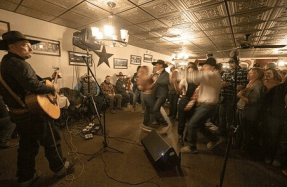Underwater Legends

THE ROAR OF THE FALLS was an unrelenting thunder of white noise. It was the mid-1950s, and Celilo Falls, on the border between Washington and Oregon — the oldest continuously inhabited spot in North America — had yet to be destroyed. Sparkling headwaters flowed from British Columbia, Montana and Wyoming, streams gathering to form the Columbia River, which surged westward through the high desert and the rainy Cascade Mountains until it yawned into the brackish slurry of the Pacific estuary. Year after year, for countless generations, millions of fish stampeded back upstream, fighting the ocean’s current to gain the forested upper tributaries, whose sheltered, transparent waters and gravel substrate provided perfect spawning grounds.
The Great River’s annual rotation of anadromous fish included steelhead trout, sturgeon, coho, chinook and sockeye salmon, chum or dog salmon and the otherworldly Pacific lamprey — a glossy-gray, eel-like fish with seven round gills bored into its sides like the tone holes of a cedar flute. Back then, whenever the adult fish returned, ocean-fresh and ripe to fill hungry bellies, the people gathered at legacy fishing spots, including Celilo Falls.
Every season had a different run: the fall, spring and summer chinook, each with its own flavor; fall dog salmon and summer lamprey. On the timber scaffolds that etched the incandescent billows of the falls, fishermen tested their strength and bravery, fighting hound-sized fish with 20-foot-long dipnets until they’d hauled in enough to feed their families for a year, share fish with elders and trade with neighboring tribes. There were millions of salmon, so many that people said you could walk across the Great River on their backs; some elders boasted that they had. The fishers camped around the falls, their pickup trucks, canvas tents and hand-crafted houses set among rows of cabin-style apartments, where permanent residents lived in multigenerational households. As the fragrance of smoldering alderwood wafted from smoking sheds, mothers and grandmothers sliced sherbet-colored slabs of fish with practiced hands, or popped dried lamprey tail into the mouths of teething babies to soothe their gums with its pain-killing oil. Children sledded down the nearby dunes on cardboard boxes, threw rocks, fetched firewood or filled buckets at the water pump.
A boy in bib overalls, Wilbur Slockish, hefted a freshly caught or dog salmon, into a wooden box, and covered it with a wet gunny sack to keep it damp. The salmon were so healthy and strong they stayed fresh even without ice. The river water was clear enough to drink. Nearby, the boy’s grandmother hung white filets on racks to sun-dry, while his father traversed a precarious-looking scaffold that jutted over the turbulent rapids. The family traveled every year from their home in Wahkiacus, a town named for the family of Slockish’s great-grandmother, a famous Klickitat basket weaver. Umatilla folks traveled from the other direction to trade blankets and hides for Grandma’s dried . The falls
You’re reading a preview, subscribe to read more.
Start your free 30 days





